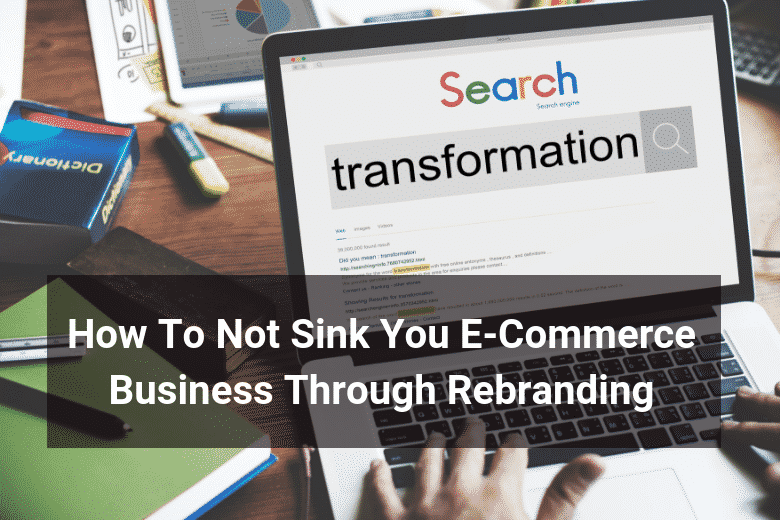One of the biggest challenges you will come across at some point when running an e-commerce business is rebranding. Now, it would be ideal if you could avoid branding altogether, but unless you are Coca Cola, which is globally recognizable, you are going to have to roll up your sleeves and rebrand your business. But even they have to do it from time, as is evident in the case of Diet Coke. Rebranding doesn’t necessarily mean that your business isn’t doing well. It mostly has to do with the constantly changing demands of the market and trends which come and go.
But, there are plenty of cases in which rebranding is used as a form of damage. Let’s take the rebranding of British Petroleum as an example. Back in 2000, they have taken their BP logo which they have used successfully, and replaced it with the new “Helios” logo, which was meant the symbolize the sun and the green growth of the company. The only thing that was really left of the logo were the colors. The rebranding was a failure, because there is nothing really “green” and environmentally friendly about drilling for oil. The “Helios” also took up more space, and it cost the company a whopping $211,000,000! And this was before the whole Deepwater Horizon oil spill in 2010.
So, whether you are a cheap custom essay writing service or a global brand, you should take rebranding seriously, because it as illustrated in the case of BP, it can cost you a lot of money. In order to avoid the most common pitfalls, check out our list of things you need to do if you want to rebrand your e-commerce and not sink it in the process.
1. Do Your Research
Rebranding should always start with research. You should start with internal research of your business or company in order to determine how it is viewed by all employees. This means you should start by asking for feedback from all departments of your business, as well as from people on all levels of hierarchy (managers, team leaders, CEO…). Collecting as much information as possible is crucial, because everyone will have their own about where your company is at the moment, as well as where it should go in the future. You will have a much clearer picture that way.
External research is equally important, because it enables you to see how your business is viewed through the eyes of your audience, your competitors, as well as what’s its current position on the market is. At this point, you should also listen to what analysts have to say about the state of the industry itself. All this information will come into play when deciding on how to rebrand your company and which message you want to convey to your target audience.
2. Go Beyond the Visuals
When you rebrand your business, things your company logo, colors, typography, and other design elements will undergo the most obvious changes, but the change should be more than skin deep. Rebranding is not just about establishing a new visual identity for your e-commerce business, but also about reposition your business on the market and changing the way how people see it. For instance, it should also involves changing your message, and improving company values.
For instance, your rebranded message should address the advantages of your products over those of your competition, as well as reasons why customers should pick your business in particular to spend their money with, and not someone else’s. Seeing as those changes reah deep beneath the surface, you should also make internal adjustments in order to support your message. Let’s you emphasize that your business offers 24/7 customer support to its customers. In order to make good on that promise, you should possibly hire and train additional staff.
3. Be Aware of Your Brand’s Market Position
While you definitely shouldn’t indulge your target audience at all costs, you still need to be aware of the fact that they expect your brand to provide a certain kind of service or uphold a particular standard. One of the best examples of how companies fail to understand this is Tropicana and their ill-fated attempt at rebranded and repacked its orange juice. The new packaging was problematic because it looked nothing like the iconic design people were used to, but also because its looks resembled those of cheaper generic brand. The backlash was fairly severe: a drop in sales of over 20% over the next several weeks, which prompted the company to reinstate the original packaging.
Although the juice itself remained unchanged, people rejected it because the new packaging didn’t resonate with them. You see, they liked the old one not just because of their brand preference and its visual identity, but because that orange juice in that particular packaging had been a part of their breakfast ritual for years. It evoked certain emotions, and PepsiCo, which owns the Tropicana brand, didn’t do their homework.
4. Produce New Content to Support the Rebranding
So you’ve changed your e-commerce’s branding and now you have a new logo and colors? Great! Your website, business cards, and social media channels reflect that new visual look? Even better! However, unfortunately, that is not enough, because the new identity isn’t going to promote itself. It needs to be backed up by relevant new content. That means your rebranding should include regular blog and social media posts, PR activities, as well as the publishing of in-depth expert content whose goal is to establish your brand as one of the thought leaders in your niche.
For instance, if you take a look at what NIke, Adidas, Reebok, and other sporting goods giants are doing, you will notice that they aren’t just talking about how incredible their products are and tooting their own horn. Instead, they have aligned themselves with goals and activities such as fitness and healthy lifestyle, and their content reflects that and supports their brand.
5. Find a Unique Selling Point
This works whether you are just trying to establish your brand from scratch or to completely rebrand it. Let’s a look at AlmazanKitchen and their YouTube channel. There you will find tons of mouth-watering recipes cooked by 2 guys in a forest, using ingredients which are fresh and their own homemade products, such as cheeses, cured meats, fermented vegetables. Each recipe is beautifully shot – in fact, they wipe the floor with its competition. If you take a look at the description of the videos, you will find that they are selling their own artisanal knives. In essence, they cook traditional food using traditional method. No place for anything that is mass-produced They found a unique selling points and producing content in order to support the brand and its product, and their YouTube following reflects that.
And you can pretty much apply the same principle regardless of your niche, and especially if your company is focused on offering high-quality products which are handmade in small series. Nowadays, people like to receive a more personalized experience. They want to get their hands on something that is not just superior in quality, but which feels more exclusive, as if it was made for them, and not 10,000 of other people. And best of all, they are willing to pay more to get that experience.
6. Discover Untapped Potential and Opportunities
Keeping an eye on industry trends is important when you are trying to build brand awareness and/or rebrand your business, but if you stick too closely to them, you risk falling into a trap of doing what everyone else in the industry is doing, and focusing on the same benefits. If were to analyze large corporate fast food chains, we would see that none of them actually emphasizes how fast you are able to get your food once you visits one of their restaurants, because that is obvious, and has been done already. For instance, Subway has focused on the “Eat Fresh” campaign, which focused on the fact that their sandwiches are made from fresh ingredients and put together when you order them.
Burger King, on the other hand, used to promote a “Have it your way” slogan, which enables customers to pick their own burger condiments, as opposed being handed a burger with your standard combo of ketchup and pickles. The points, they found new opportunities that would position their brand in a unique way, which ultimately set them apart from the competition.
7. Stay Focused on Your Brand New Image
So, you’ve slapped a brand new visual identity on your brand, improved the quality of your product/service, and your job is pretty much done, right? Not exactly. While it’s OK to take a break from the total rebranding of your e-commerce business for a bit and focus on other aspect of doing business, you should still keep an eye on how your brand is being accepted. When you put a new marketing campaign in motion, you wouldn’t just call it a day afterwards. You would monitor and analyze traffic, click-through rates, and conversion numbers. The same goes for rebranding. Only then will you be truly able to tell if it has worked for the better.
Conclusion
Rebranding is a big undertaking for every business, and one which can prove to be damaging if you fail to tick all the right boxes. But, if you do it properly, as described in this article, it can become a wonderful opportunity to reinvent your brand and take into a new and exciting direction. Good luck!
Author
Susan Saurel is a passionate writer from Texas. She is in love with traveling. Teacher of higher category, a writer for cheap essay writing service EssayWritingLand, PM in an IT company, lovely mom. She wants to share her experience and knowledge with readers and she has something to say, for sure. You can get in touch with her via Twitter

Ready To Upgrade Your Logistic Solution?
Speak to Floship ecommerce logistic consultant about improving your global support chain today




